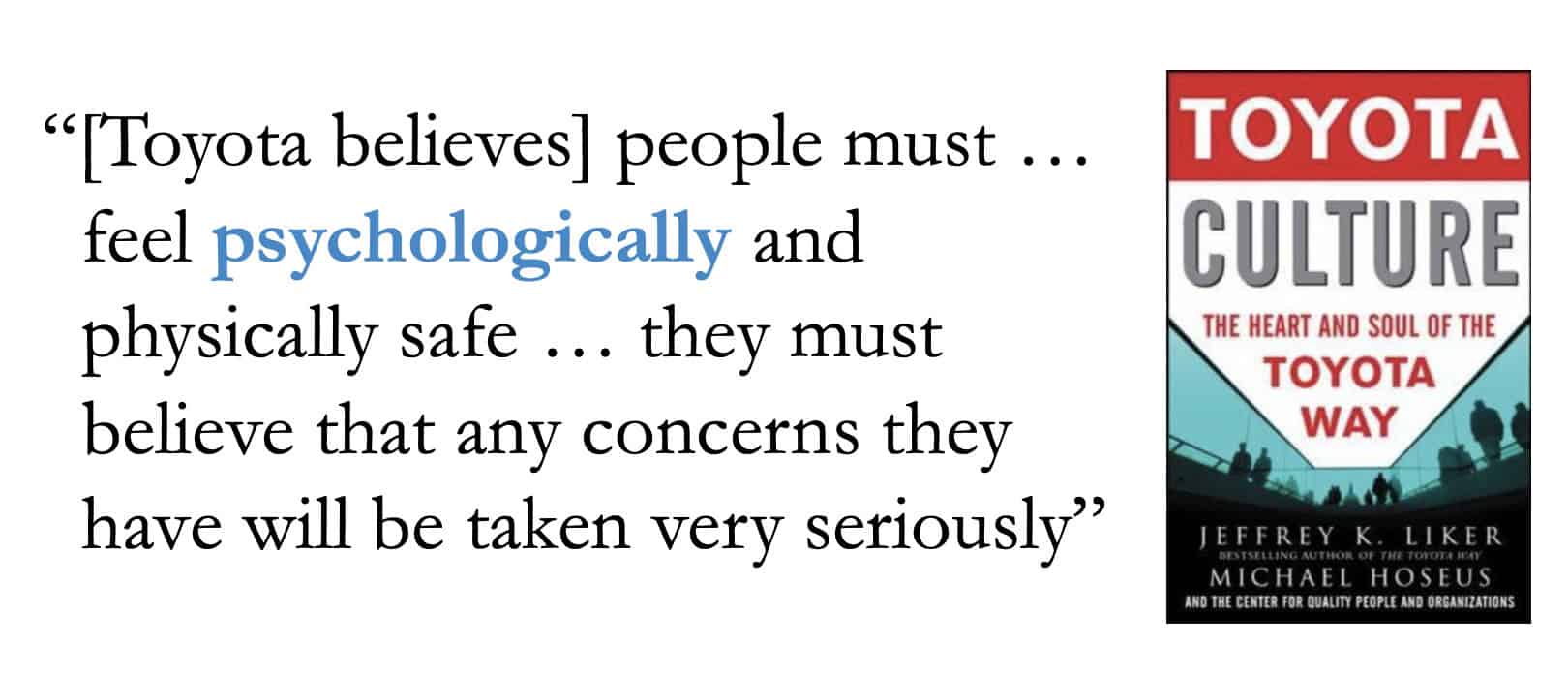Before I departed for my recent workshop tour of Australia and New Zealand, I knew that I would learn things in the process of teaching and facilitating on my favorite topics. I didn't expect to learn about flying koalas, though!
I did expect to learn something when I had the opportunity to meet up for lunch with a friend, former Toyota Australia leader Barry McCarthy. Barry's also the chair of this year's AME International Conference in St. Louis. I first met Barry back in 2018 when I went on a Japan Study trip with Barry and the Honsha Consulting team, and I learned a lot from him on that trip (check out my podcast with him about these topics).
Toyota and Psychological Safety–A New Book
In recent years, I've come to believe that Psychological Safety is the oft-unheralded foundation of the Toyota Production System and Lean Management. Former Toyota Kentucky leader Mike Hoseus agrees, as we discussed in this Lean Blog Interviews episode — and as mentioned in the book Toyota Culture, that Mike co-authored with Jeff Liker.

I've learned a lot from Barry about Toyota as a “human development company,” as we discussed in his episode.
He agrees with me about the direct importance of Psychological Safety at Toyota — and that it's something they intentionally nurture.
One new piece of direct evidence of this is a book that was published, in Japanese, back in late 2023. The title can be translated to English as:
Barry shared his summary of the book (as translated by him via Google) and I ordered it from Amazon Japan based on his recommendation. When I got home, the book was waiting for me.
“DX” is jargon (an abbreviation) for “digital transformation,” something that's increasingly important to Toyota.
Back to the title — I suspect that “make work flow better” might be a better translation since we don't normally try to “speed up work” directly through the Lean methodology. Lean is more about reducing and eliminating barriers to flow and not a matter of pressuring people to work faster.
The ChatGPT translation of the title says:
“Supporting Toyota-Style DX: Two Kata That Achieve Psychological Safety and Speed in Work”
“A way of speaking that resonates with young workers” and
“A way to move work forward”
I've been running pages through ChatGPT as a translation tool. It's incredibly fast. You take a photo of a page (or pages) and out comes the translation. I've been uploading photos in a batch size of “chapter” so ChatGPT can perhaps look at the full context of the chapter instead of only seeing page by page.
Problem Statement
Before jumping into what Psychological Safety is, the book poses a problem statement:
“A diagnostic list for managers–if you mark 3 or more “yes,” you should seriously reconsider your current management style. Examples include:
- “I've never said ‘thank you' to a team member today.”
- “I find the word ‘challenge' cringeworthy.”
- “I haven't talked to anyone outside my own department.”
- “I tend to suppress my real opinions at work.”
I think a good question for leaders is: “Do you remember the last time an employee disagreed with you?” If the answer is “no,” then you have a problem.
What is Psychological Safety — And Why?
(1) What is Psychological Safety?
“Being able to express honest opinions, candid doubts, and even disagree with others for the sake of organizational or team results–without fear.”
— Atsusuke Ishii, 2020, Japanese Management Skills Association
I think that's a great definition. The standard definitions of Psychological Safety, from Amy Edmondson and others, is that P.S. is about feeling safe to speak up about, basically, anything at work.
Is Psychological Safety just a nice way to treat people? No. It's also about business success:
“Psychological safety is a leading indicator for organizational learning, growth, and long-term performance.”
The book also does a good job of explaining what P.S. is NOT:
A common misunderstanding is to associate psychological safety with a “soft” or “low-pressure” environment. But “psychological safety” doesn't mean “you don't have to work hard.” That would create a dead workplace.
Toyota's goal is a “learning organization,” not a soft one.
Respecting every individual means challenging them because you believe they can do better… not being soft or easy on them.
The book explains how P.S. is an imperative–that reducing fear leads to more innovation and that's why “…Toyota is investing so deeply in psychological safety.”
“Improving psychological safety became a precondition for advancing digital transformation.”
How did Toyota prove the connection?
“In employee satisfaction surveys, a surprising result emerged: when psychological safety increased, scores in well-being, communication, and innovation all rose.
The impact was especially visible in locations where teams created a safe space for honest feedback and mistake-sharing.”
What Next?
Psychological Safety isn't just a nice-to-have — it's foundational to Toyota's success and to any organization striving for continuous improvement and innovation. Whether you're inspired by global insights or challenged by your current culture, the path forward begins with understanding your baseline and taking intentional steps toward a safer, more open environment for your people.
If you want help assessing the current state of psychological safety in your organization — or if you're ready to start improving it — contact me. Let's talk about how we can build a culture where people feel safe to speak up, share ideas, and learn from mistakes.
What do you think? Please scroll down (or click) to post a comment. Or please share the post with your thoughts on LinkedIn – and follow me or connect with me there.
Did you like this post? Make sure you don't miss a post or podcast — Subscribe to get notified about posts via email daily or weekly.
Check out my latest book, The Mistakes That Make Us: Cultivating a Culture of Learning and Innovation:










[…] Source: How Psychological Safety Drives Digital Transformation and the Toyota Production System (or Lean) […]